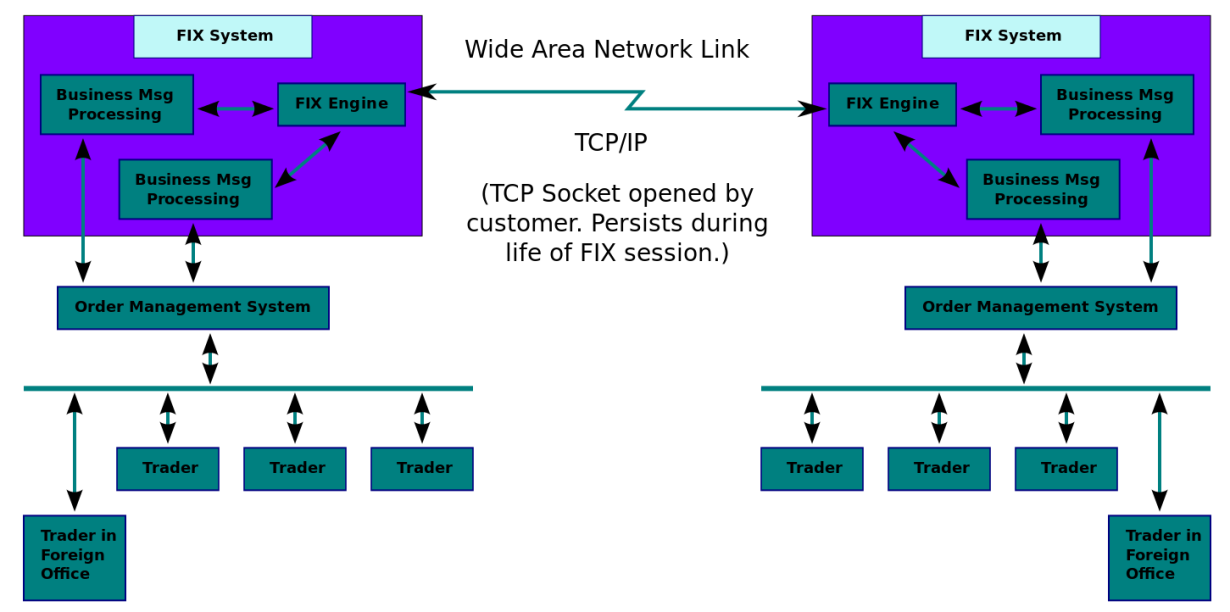The Financial Information eXchange(FIX) protocol is an electronic communications protocol initiated in 1992 for international real-time exchange of information related to the securities transactions and markets. It was initiated by a group of institutions interested in streamlining their trading processes. These firms believed that they, and the industry as a whole, could benefit from efficiencies derived through the creation of a standard for the electronic communication of indications, orders, and executions. The result is FIX, an open message standard controlled by no single entity that can be structured to match the requirements of each firm.
FIX has become the language of the global financial markets used extensively by buy and sell-side firms, trading platforms and even regulators to communicate trade information. This non-proprietary, free and open standard is constantly being developed to support evolving business and regulatory needs and is used by thousands of firms every day to complete millions of transactions.
FIX is the way the world trades and it is becoming an essential ingredient in minimizing trade costs, maximizing efficiencies and achieving increased transparency. FIX offers significant benefit to firms keen to explore new investment opportunities, it reduces the cost of market entry with participants able to quickly communicate both domestically and internationally, in addition to significantly reducing switching costs.
What FIX does for us:
- Provides an industry standard means to communicate the information you wish to communicate electronically. This could be:
- Indications of Interest
- Orders and Order Acknowledgment
- Fills
- Account Allocations
- News, E-Mail, Program Trading Lists
- Administrative Messages
- Connects us with an expanding list of buy and sell-side institutions
- Delivers information in real-time
The Following type of securities we can process via FIX:
- US Equities
- International Equities (all markets)
- ADRs
- Convertible Bonds
- Futures
- Foreign Exchange trading
- Fixed Income
Pictorial representation of FIX system:
The given diagram shows how FIX messaging looks between Buyside/Customer and Sellside/Supplier.

FIX message format layout:
The FIX message is a combination of header, body, and trailer. That means header + body + trailer = FIX content.
Up to FIX.4.4, the header contained three mandatory fields: 8 (BeginString), 9 (BodyLength), and 35 (MsgType) tags.
Example of a FIX message: Execution Report (Pipe character is used to represent SOH character)
8=FIX.4.2 | 9=178 | 35=8 | 49=PHLX | 56=PERS | 52=20071123-05:30:00.000 | 11=ATOMNOCCC9990900 | 20=3 | 150=E | 39=E | 55=MSFT | 167=CS | 54=1 | 38=15 | 40=2 | 44=15 | 58=PHLX EQUITY TESTING | 59=0 | 47=C | 32=0 | 31=0 | 151=15 | 14=0 | 6=0 | 10=128 |
Body Length:
Body length is the character count starting at tag 35 (included) all the way to tag 10 (excluded) which is for checksum. SOH delimiters do count in body length. Tag 9 represents body length. In the above example body length of this message is 178.
Checksum:
The checksum algorithm of FIX consists of summing up the decimal value of the ASCII representation all the bytes up to but not including the checksum field (which is last) and return the value modulo 256. Tag 10 is used for checksum value, in the above example checksum value is 128.
In a nutshell, we can say that FIX standard is a unified stack for all trading related messaging process. We can use FIX to send order, allocation, allocation instruction and its execution related message. It also supports confirmation, acceptance and rejection type of acknowledgment messages to send a report back to the client about his order’s execution status.
To get more information about FIX, you can visit the official site.



Reblogged this on Coding, Unix & Other Hackeresque Things.
Thank you. A very good basic introduction that I actually understand!